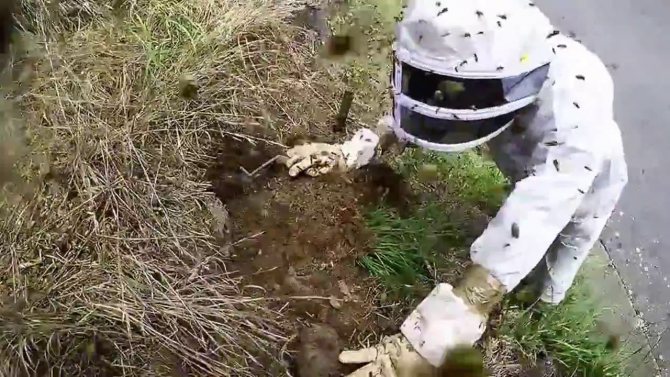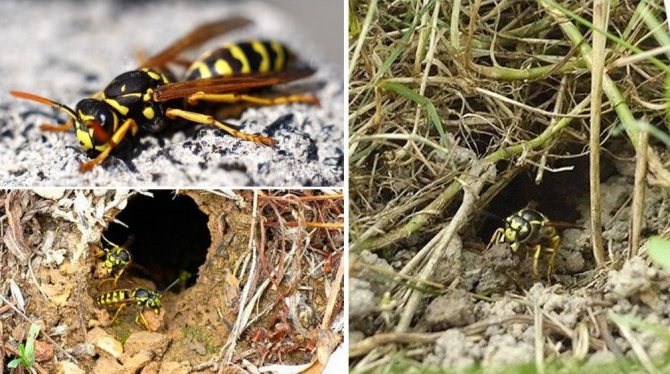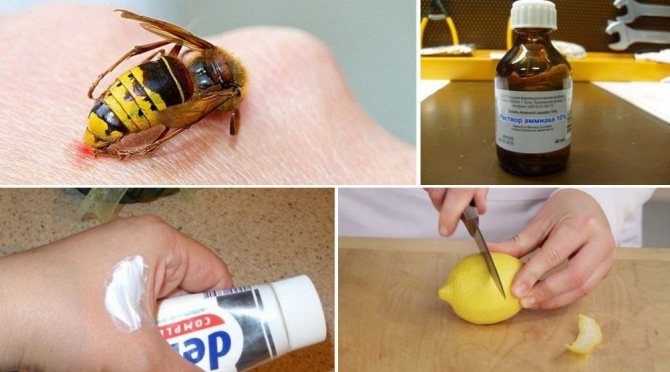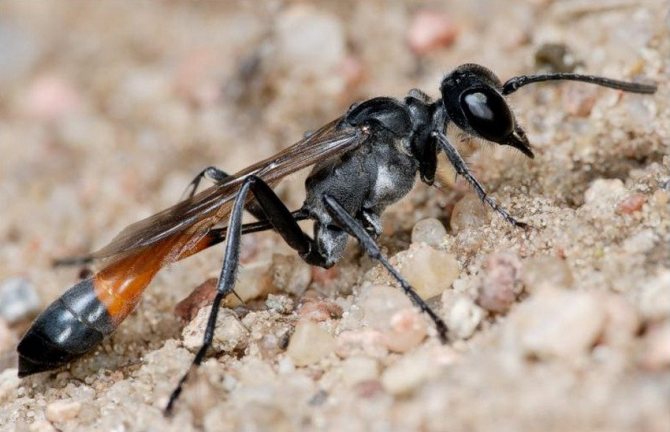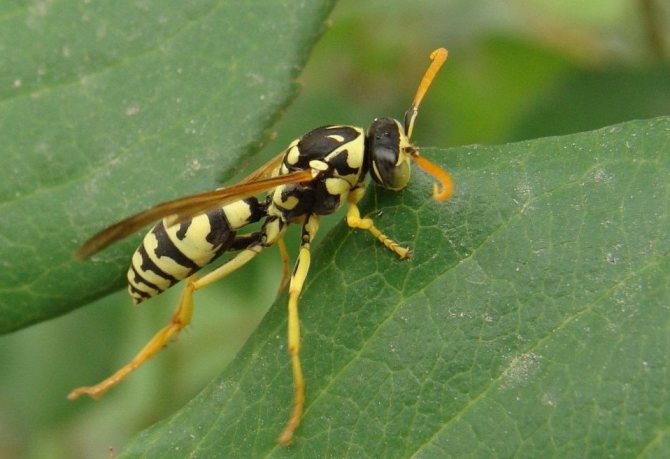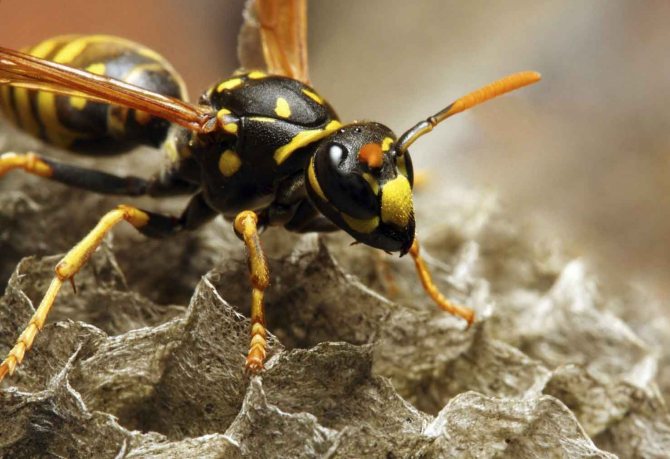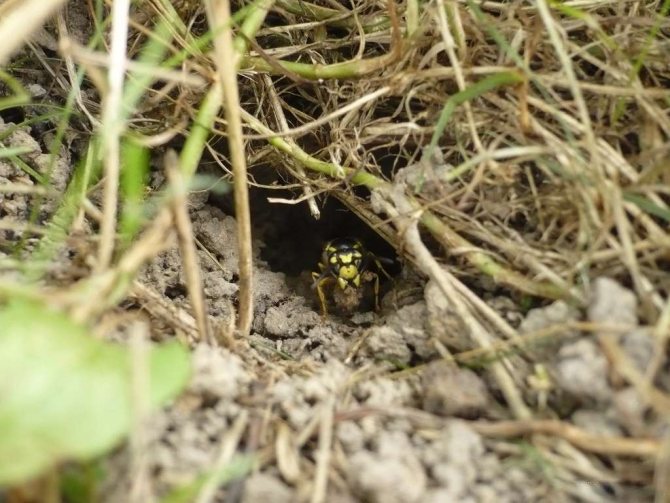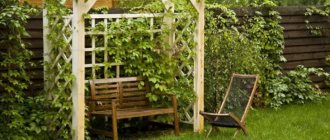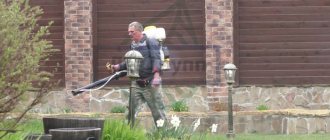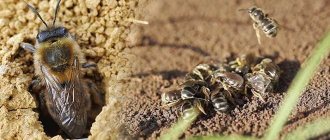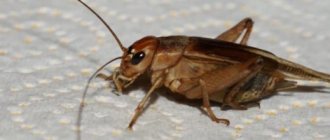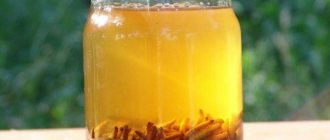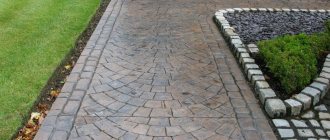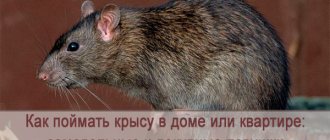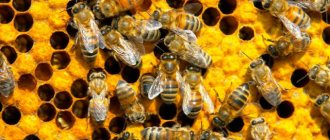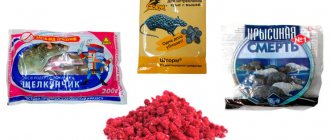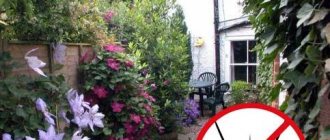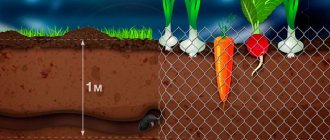Earth wasps in the garden are dangerous. Despite the fact that they are excellent at fighting various pests, these insects do more harm than good. It is by bites that earthen wasps are dangerous. How to get rid of nests and insects quickly and easily? Probably, this question worries almost every summer resident. In achieving the cherished goals, many make typical mistakes, and some really lead to attack from their site. Let's see which method is the most effective.
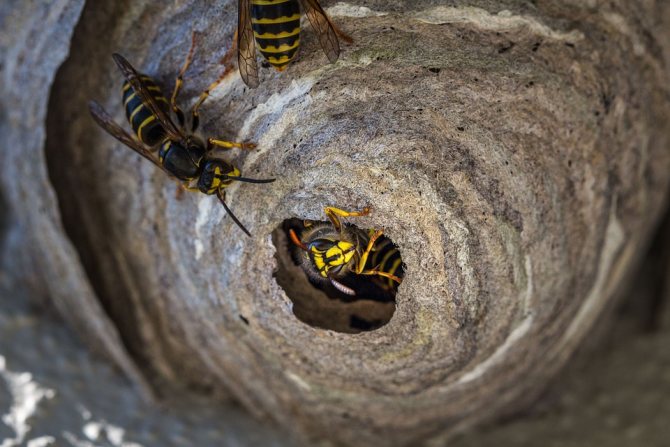
Fresh articles about garden and vegetable garden
How to germinate peas for planting on the site and for eating at home
Anthurium flower male happiness, proper care and reproduction
Learn all about peonies Mr. Ed; photo with a description, features of care
Description of the earthen wasp
Depending on the species, an adult wasp grows to 1–10 cm. Females are usually 1–2 cm larger than males and working wasps. The body of insects consists of a body, tapering towards the end, and connected by a thin jumper of the head and chest. It is either covered with fine hairs or there is no pubescence at all.
In addition to the traditional black and yellow coloring, the body of insects can be black or dark brown with white, red, orange stripes and spots. Bright stripes are found not only on the body, but also on the head and legs.
Earthen wasps have 2 pairs of webbed thin wings. They are transparent colorless or with a blue, black, reddish or brown tint. There are a pair of antennae on the head of different shapes and lengths. They pick up sounds and smells like antennas.
Feet have 5 segments. With their help, insects move, grab prey. Unlike common wasps on the forepaws, species that independently dig holes in the ground have a row of stiff setae, similar to a comb. They help them to recline the soil.
Large compound eyes provide good vision for wasps. Insects do not have teeth, but they have powerful jaws, which can easily bite through the dense cover of the victim.
A sting-needle is hidden below on the abdomen of females. It is connected to the gland that contains the poison. The female's sting is used for hunting prey, for defense and protection of the nest.
Precautions
It is necessary to deal with small wasps very carefully, reducing the danger to a minimum.
Before as get rid of earth wasps, a person must take care of their protection. The best thing is to wear a regular beekeeper costume. If you cannot find one, then you can use any closed clothing made of impenetrable and dense fabric. The face and eyes should be protected with a mask, and a hat should be put on the head.
It is forbidden to make loud sounds and make sudden movements. Burrowing wasps have amazing hearing, so they react immediately.
Get rid of such insects necessary in the dark, as in the evening the wasps begin to prepare for bed. In this case, you can easily eliminate the whole family together with the larvae. If insects suddenly fuss and begin to fly out of their nest, you should immediately take refuge in some kind of closed room.
The life of a wasp uterus: what does a queen wasp look like and what is its task
Views
Sand (burrowing) wasps
This is a group of solitary carnivorous wasps 2–5.5 mm long. Insects have a small head, straight antennae and long legs. The majority of representatives are black with a red stripe or spots on the abdomen.There are types of black with yellow or white stripes. The pronotum in all sand wasps resembles a ridge. The most famous burrowing species are: wasp larra anathemskaya, wasp ammophila, philant.
Road wasps
Insects with an elongated black body 1.5–4 cm and long curled antennae. There are red or yellow spots on the abdomen. The wings of road wasps are darkened: black, black-blue or brown. The road wasps are active and constantly move in search of prey.
German wasps
Outwardly they are similar to an ordinary wasp, but smaller in size. The body of an adult is 12–15 mm long. The tip of the abdomen of this insect is not black, but yellow. The colony is smaller than that of the common wasp.
Floral
Small insects no more than 1 cm in length with a black and yellow belly. In the ground, the uterus most often build single nests from a mixture of clay, sand, moistened with saliva.
Scoli
Members of this family are solitary wasps. Depending on the species, insects grow up to 1–10 cm. The body of many skoli is densely covered with hairs. The color is black with yellow, white, red stripes and spots.
Burrowing wasps Sphecidae, road wasps Pompilidae.
Larra is hunting a bear.
Almost all of these beneficial insects take care of their offspring, but different species have differences in the construction of a shelter for the offspring and the way they are fed. They also bring different prey. There is, however, among them the species of burrowing wasps Larra, which lay an egg on a serious pest living in the land of damp vegetable gardens - the bear. Larra drives the bear to the surface, temporarily paralyzes it with three stings in three thoracic segments and lays an egg under the base of the front leg of this large insect. After a few minutes, the bear crawls underground, and the larva of the larra emerges from the egg and parasitizes on it.
Sandy ammophile.
Ammophiles (Ammophila) dig a burrow about 5 cm deep with a chamber expanding at the end. Having laid a mink with a stone, it often sets off for prey the next day. Having dragged the immobilized, but live prey into the burrow, the female lays an egg and seals the entrance, filling it with sand and pebbles, or in another way. Then the wasp carefully masks the entrance.
Sandy ammophila hunts a caterpillar.
The sandy ammophila preys on the ground moth caterpillars. Sensing a caterpillar underground, ammophila digs it out of the loose earth and immobilizes it, stinging into the nerve node of each segment, starting from the head.
The fluffy ammophila brings up to ten small moth caterpillars for each of its larvae, gradually adding food, and only then seals the mink.
Many burrowing wasps bring adult insects for their larvae, hunting them. Most of the lumpy wasps (Cerceris) prepare small gold beetles, leaf beetles, weevils for the offspring, paralyzing them. It is interesting that they live in colonies, so the surface of the earth in such places is covered with craters of discarded earth, and pitted with burrows like a sponge.
Big-headed wasps (Crabro) gnaw passages in the rotting wood of old stumps and prepare various insects for the offspring - they catch flies, bedbugs, leafhoppers, butterflies, hay-eaters and even beetles.
The nosed bembex (Bembex rostratus) are very interesting - they hunt adult flies. These are striped wasps with a wide belly, burrowing burrows in loose sand. They give each dead fly larva 2 weeks while it grows. The same mink serves as a refuge for the nosed bembeks in rainy weather, and about 60 flies or about 24 horseflies are required to raise each larva.
The tiny spilomen (Spilomena troglodytes) makes several nests in one straw, bringing there paralyzed thrips, one of the smallest winged insects, for their larvae.
Features of life
To the construction of nests earthen wasps begin in the spring at the first warming.Some species settle in sandy soil, while others choose dense soil. Females are engaged in the choice of a suitable place.
The wasp digs the ground for the burrow with its paws, with which it pushes the soil away like a shovel. Powerful jaws are connected to the work, and the wings help to break through the dense layers. The insect waves them continuously, the air gets into special bags on the chest. The muscles contract, and the air is pushed from the sacs through special channels to the jaws. They begin to work at such a frequency that a depression is formed with a slight touch on the ground.
Insects can settle in a burrow abandoned by rodents, in voids under the soil, near roots and dead trees, in an old anthill.
In an underground dwelling females build honeycombs just like outside. From the chewed fibers of wood and saliva, a mass is obtained, which, when solidified, looks like paper. From it, the uterus builds the first 5-10 cells and deposits in them eggs... After 1-1.5 months appear larvae... The female takes care of them, brings protein food to each cell, and herself feeds on flower nectar. When the larvae turn into adult insects, they connect to the construction of the nest for new family members, looking for food, guarding and protecting home.
By the end of summer, the colony of social wasps reaches its maximum size and numbers several thousand working wasps and heterosexual individualsready to reproduce. Only fertilized young females hibernate., the rest of the colony members die.
Solitary species of ground wasps live separately, build small nests or occupy soil voids for reproduction. The female catches a small insect: a spider, a caterpillar, a fly and paralyzes the victim with poison. It lays an egg on its body and hides its prey in a hole. She will be food for the larva that has appeared, since the wasp does not care for the offspring. She immediately leaves the dungeon and clogs the entrance. The young wasps that have grown from the larvae independently get out in the spring.
Features of insects: where do they live, what do they do?
Earthen wasp nests look like normal hives. At first glance, it may seem that there is very little space in them, but this is not so - one standard brood and several other wasps are placed in a standard nest. Usually insects build them close to each other - this makes it easier for them to feed their offspring. This does not mean that you cannot have only one nest on the site, but, as a rule, there are more of them.
The brood feeds on the corpses of insects that remain after the work of spiders. The same organic remains are the material for building nests. Adults eat plant pollen, nectar, small midges and aphids. Visually, earthen wasps are very similar to hornets, but hornets are larger in size.
The main danger posed by earth wasps:
- they destroy not only pests, but also pollen, without which bees will not be able to collect enough honey;
- wasps are very aggressive insects, they can be harmful to humans, they must be exterminated in those areas where there are small children;
- the presence of earthen insects complicates work in the garden and garden - if you violate the integrity of their nest, they will go on an active offensive;
- Wasp bites are usually accompanied by an allergic reaction, severe edema, and an increase in overall body temperature.
It is interesting Preparation Aqua Flo for treating bees from ticks
What happens if you don't touch the insects? Solitary individuals will not harm you much, but you definitely need to do something with the nests. By the way, single individuals are considered to be strong poisonous predators.
What harm do earth wasps do?
Ground wasps, as well as their relatives living in outdoor nests, aggressive and sting... Insects love to settle in light and loose soil in garden beds, in elevated flower beds and alpine hills, under the roots of berry bushes.Meeting them will be an unpleasant surprise during the harvest. Earth wasps will surely take revenge for an attempt on their territory.
Neighborhood with wasps is undesirable and dangerous if there are allergy sufferers and small children in the family.
Wasps are susceptible to strong aromas. Flock to the smell sweet fruits, drinks, meat, fish and are very annoying. Spoil fruits and berries on trees and shrubs.
Insects search for sweet food in garbage dumps and compost heaps, and then bring and leave putrefactive bacteria on the table, dishes, food in the house.
If on the site or there are bee hives in the neighborhood, then predatory wasps will kill bees.
Basic drugs
The most common agent used to control wasps is, as we mentioned above, industrial chemicals. They include insecticides of intestinal action. The most popular formulas are:
- Mosquito is a toxic agent, it should be used only in a special mask to protect the respiratory system. Not suitable for the treatment of residential premises.
- Gett is a product that is safe for the health of people and animals; it destroys insects quickly and for a long time (the effect lasts about six months).
- Troapsil is a new drug that has a high degree of insecticide concentration. Before use, dilute it with water - the proportions are about 1 liter of the drug per 35 liters of water.
Helpful advice. For the insecticide to work as efficiently as possible, cover the area to be treated with regular plastic wrap. The bag should be put directly on the socket, do not forget to glue the ends of the bag with tape. A small hole is made in the film - an insecticide is injected through it.
How to get rid of ground wasps
Lures and traps
The bait is prepared by mixing sweet syrup, jam diluted with water, fermented kvass or beer with insecticide without a pungent odor. The bait is poured into a saucer and placed next to the burrow. Adult insects taste the poison and die. Within 2 weeks, a fresh solution is added to the saucer in order to destroy as many pests as possible.
The bait is poured into a wasp trap made from a plastic bottle. The upper part is cut off from it, turned over and inserted downwards with the neck inside the other part of the bottle. The walls are secured with tape or staples.
Instead of liquid bait, a piece of meat, fish, fruit treated with an insecticide is placed in the trap. Solid poison can be immediately laid in wasp holes.
Traditional methods
Instead of chemicals, boric acid is added to the bait: 10 g of powder per 1 liter of sweet base.
Wasp holes and insect clusters are poured with boiling water, and crawling wasps are destroyed. Protect the body from bites before processing with tight clothing.
Insects are sprayed with soapy water. It sticks to the body, prevents them from flying and breathing.
Chemical and biological products
Dr. Claus from wasps
The insecticide contains the poison alpha-cypermethrin. It is sold in plastic containers with a removable refillable injector. The drug can be sprayed from a bottle or connect a hose and fill a hornet's nest with poison.
Mosquitoll from hornets' nests
The agent is in a high pressure canister and is used for spraying. A powerful stream of the drug overtakes the wasps at a distance of up to 6 m. This will allow you to safely get rid of insects.
Similar aerosol insecticides are Diflophos Neo, Super Cobra, Raptor, Bros, Clean house, Universal Kombat.
Geth
A modern drug based on chlorpyrifos with a prolonged action up to 6 months.
Used as an additive in baits and for processing wasp nests. In 1 liter of a sweet solution of water with jam or fermented kvass, beer is poured 100 ml of insecticide. It does not have a pungent smell, so it will not scare away the pest.
To destroy the nest, the consumption rate of the drug is 100 ml per 2 liters of water. Prepare the required amount of solution and pour it into the aspen hole or spray it.
Methods for removing wasps from the land
If you find wasps in the country and want to get rid of them, check out the possible ways to deal with earth wasps at home. It is better to carry out the procedure for the destruction of uninvited neighbors in the evening, when it gets dark. At this time, striped insects with the whole family sit in the nest. You can destroy a hornet's nest in the following ways:
- Burn them out. To do this, take 1 or 2 liters of any flammable liquid, carefully pour it into the hole, make a narrow path and set it on fire. Honeycombs made of paper will burn instantly and without residue, and with them all the insects in them.
- Pour boiling water over them. Boil 2 - 3 buckets of water, take it outside and pour it into the hole in the mink. Then immediately cover it with a stone, brick, or other suitable heavy object to prevent insects trying to get out. It is possible that you will need to pour out again, as some wasps may survive after the first time.
- Treat with insecticides. Pour a solution of insecticidal preparations into the mink, for example Cucarachi, Geta, Karbofos, Aktara, Tsimbush, Moskitol, Solfisan, Troapsila. And so that insects do not crawl out to the surface, plug the entrance with a rag soaked in the same solution.
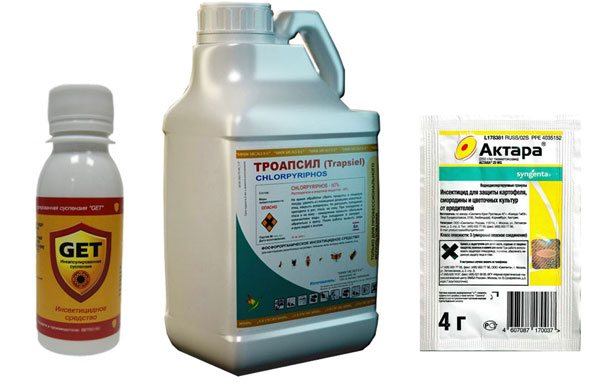

It is also possible to exterminate wasps using bait with poison. The effect from them is not as fast as from the previous methods, but it is there. To make bait, take 1 - 2 tbsp. l. any honey or thick berry or fruit syrup, mix the treat with an odorless insecticide. Boric acid is also suitable. Pour the poisonous mixture into a saucer or plastic lid and leave in a place where earthworms will notice them. They will fly to the smell, eat the poison and die. To get rid of stripy neighbors completely, renew the bait for 2 weeks.
How to get rid of a wasp nest?
- Having found a wasp hole in the ground, it is poured with boiling water. In the evening, when the adults return home, the passages are filled with hot water and the hole is completely covered with stones. The next day, the treatment is repeated to get rid of the remaining insects. The underground honeycomb is removed from the soil and destroyed, and the voids are filled with earth. Such a serious procedure is carried out in protective clothing.
- The wasp's nest is destroyed by fire. Flammable liquid and oily substances are poured into the passages and set on fire. Most of the underground inhabitants will die, but this method is controversial and unsafe. Not every gardener decides to use it in their beds, flower beds, near trees and shrubs.
- Ground wasps can be smoked out of the nest. A fire is made or a piece of rubber is set on fire next to the wasp dwelling. The pungent smoke will cause the wasps to leave the hive.
Why wasps are useful
Earthen wasps that have settled on the edge of a large plot of land are low-hazard and even useful for the owner of a garden or vegetable garden. In spring, like many other insects, they actively participate in pollination of plants: in search of nectar, they transfer pollen from flower to flower on their paws. So they make a tangible contribution to the overall yield of fruit crops.
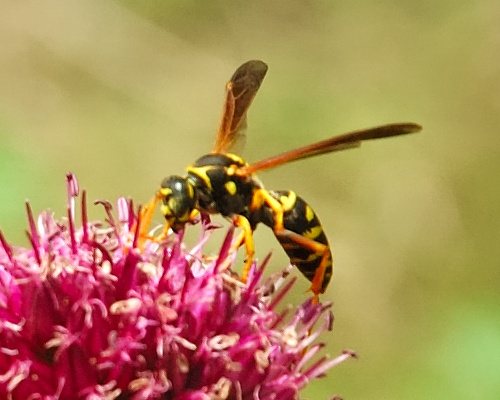

In addition, burrowing wasps protect the future harvest well from various insects that eat cultivated plants and fruits with great appetite. Because caterpillars, aphids, flies, bedbugs and other insect pests account for an impressive part of their diet. One individual can eat up to several dozen insects per day! That is, a hornet's nest on a land plot is a kind of help in the economy.
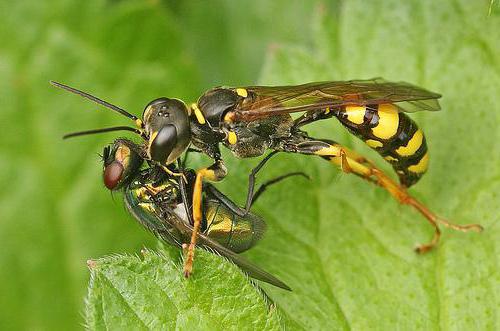

In the photo, an earthen wasp eating another insect
What if bitten by an earthen wasp?
The bite of an earthen wasp is painful, resembles burn pain... The site of the lesion on the skin becomes red and swollen. The most dangerous are insect bites on the face, tongue, neck... Suddenly, a severe allergy may appear and the person will need medical attention.
Simple actions will ease the condition of the victim:
- the bite site is washed with cold water and treated with lemon juice, vinegar, parsley decoction, or a fresh plantain leaf is applied;
- a cold compress is applied to the swelling and an antihistamine is given to the victim to drink;
- after a bite, they drink more liquid: water, tea, sour drinks.
Alcohol is excluded within 2 days, it can increase puffiness. During this period, the condition of the victim is closely monitored. If the inflammation intensifies and is accompanied by fever, suffocation, dizziness, you should immediately go to the hospital.

